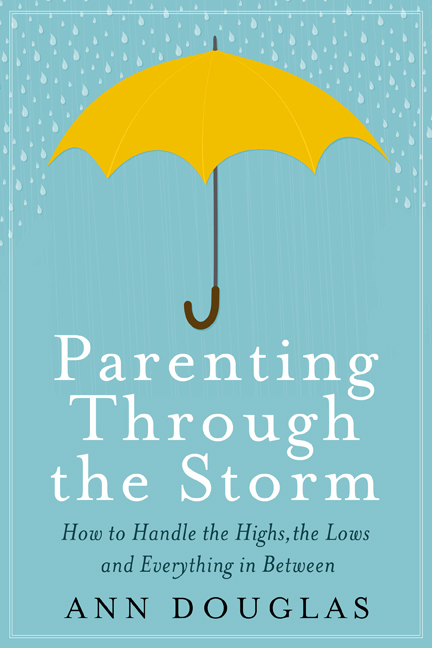Table of Contents for Parenting Through the Storm by Ann Douglas
The table of contents for Parenting Through the Storm: How to Handle the Highs, the Lows, and Everything in Between by Ann Douglas (HarperCollins, January 2015), a guide to parenting a child who has a mental health, neurodevelopmental, or behavioural challenge.
Introduction
Why I wrote this book
Who this book is for
A quick note about language
How to navigate through this book
PART I: THE CHALLENGE AND YOUR CHILD
Chapter 1. Parent Radar
What can I do if I suspect my child has a mental health,
neurodevelopmental, or behavioural challenge?
How you may be feeling
Taking care of yourself
Chapter 2. Obtaining a Diagnosis
Beginning your quest for answers: the doctor
Beginning your quest for answers: the school
Private assessment
If you’re dealing with a crisis situation
The truth about labels
The waiting game
What to do while you wait
You have the diagnosis: Now what?
What if you don’t agree with the diagnosis?
Talking with your child about the diagnosis
How you may be feeling
Confronting stigma
The blame game
What you can do to help now
How to get support
Chapter 3. Starting Treatment
Making decisions about treatment
What’s on the therapy menu?
Hospital-based treatment and residential treatment
The great medication debate
Talking to your child about treatment
What to do if you’re worried about the effectiveness of treatment
What to do if you’re worried about the quality of treatment
How to get support
Chapter 4. Advocating for Your Child
Checklist: record-keeping for advocacy purposes
Feeling let down by the system
Finding other allies in the quest for better care
Staying strong
PART II: YOU AND YOUR CHILD
Chapter 5. Stress Management and Coping Skills
Shifting your thinking
Boosting positive emotion
Learning how to relax
Other mind and body practices
Chapter 6. Parents Can Make a Difference
Building on the loving attachment between you and your child
Being your child’s voice
Validating your child’s emotions
Creating a predictable environment
Being a positive parent
Fostering confidence in your child
Practising mindful parenting
Moving forward
Chapter 7. Calming the Raging Storm
Raising an emotionally literate child
What you can do
Handling angry outbursts
Helping your child to manage feelings of anxiety
This is your child’s brain on emotions
You have the power
PART III: YOUR FAMILY
Chapter 8. Family Matters
Taking care of your other children
Staying connected as a couple
Creating a circle of support
Chapter 9. Lifestyle Matters
How sleep can improve mental health
How exercise can improve mental health
How play can improve mental health
How nutrition can improve mental health
What you can do
PART IV : YOUR COMMUNITY
Chapter 10. Working with Your Child’s School
The types of difficulties your child might be experiencing at school
Putting supports in place: what you can expect from your school
Working with your child’s teachers
Working through the tough stuff
Discipline revisited
To high school and beyond
Chapter 11. The Friendship Department
Helping your child learn how to make and keep friends
How being bullied affects mental health
Why children with mental health, neurodevelopmental, or behavioural
challenges are more likely to be bullied
Why some children with mental health, neurodevelopmental, or
behavioural challenges are more likely to bully other children
What you can do to reduce the chance that your child will become
a bully or a victim
Chapter 12. Finding Community
Seeking support
Taking a break
Finding allies at work
PART V: RECOVERY AND BEYOND
Chapter 13. Destination: Recovery
What recovery means
Emphasizing love and acceptance is key
Celebrating successes along the way
Dealing with setbacks
Handling a crisis
Communicating with your child during a crisis
Hopes and dreams revisited
Endings and beginnings
Chapter 14. Creating a Better System
A system that emphasizes prevention and early treatment
A system that makes sense to families
A system that treats parents as partners
A system that allows for seamless transitions between the adolescent
and adult mental health care systems
A system that works for people who are struggling with concurrent
disorders
A system that is accessible to everyone
A system that is adequately funded
Epilogue: After the Storm
Appendix A: Glossary
Appendix B: Directory of Resources
Appendix C: Directory of Disorders
Acknowledgements
Index
